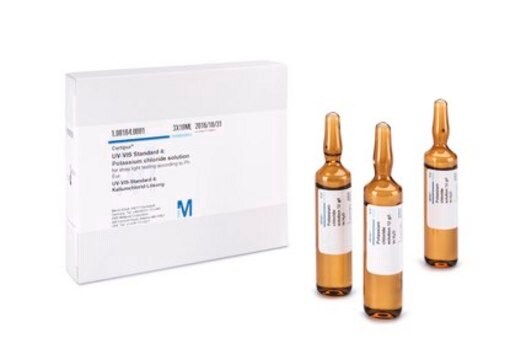1.04372
Hexane
≥99% (GC), suitable for UV/Vis spectroscopy, Uvasol®
Sinónimos:
n-Hexano
About This Item
5.2 psi ( 37.7 °C)
~132 mmHg ( 20 °C)
Productos recomendados
Nombre del producto
Hexano, for spectroscopy Uvasol®
densidad de vapor
~3 (vs air)
Nivel de calidad
presión de vapor
256 mmHg ( 37.7 °C)
5.2 psi ( 37.7 °C)
~132 mmHg ( 20 °C)
Ensayo
≥99% (GC)
Formulario
liquid
temp. de autoignición
453 °F
potencia
25000 mg/kg LD50, oral (Rat)
>2000 mg/kg LD50, skin (Rabbit)
lim. expl.
7.7 %
técnicas
UV/Vis spectroscopy: suitable
impurezas
≤0.0002 meq/g Acidity
≤0.0002 meq/g Alkalinity
≤0.005% Water
residuo de evap.
≤0.0002%
color
APHA: ≤10
transmitancia
195 nm, ≥10%
210 nm, ≥60%
217 nm, ≥80%
225 nm, ≥90%
245 nm, ≥98%
índice de refracción
n20/D 1.375 (lit.)
Viscosidad cinemática
0.50 cSt(20 °C)
bp
69 °C (lit.)
mp
−95 °C (lit.)
temperatura de transición
flash point -22 °C
densidad
0.659 g/mL at 25 °C (lit.)
Absorción UV
λ: 195 nm Amax: ≤1.00
λ: 210 nm Amax: ≤0.22
λ: 217 nm Amax: ≤0.10
λ: 225 nm Amax: ≤0.05
λ: 245 nm Amax: ≤0.01
temp. de almacenamiento
2-30°C
cadena SMILES
CCCCCC
InChI
1S/C6H14/c1-3-5-6-4-2/h3-6H2,1-2H3
Clave InChI
VLKZOEOYAKHREP-UHFFFAOYSA-N
¿Está buscando productos similares? Visita Guía de comparación de productos
Descripción general
Aplicación
- Enhancing the selectivity for light olefins through catalytic cracking of n-hexane by phosphorus doping on lanthanum-modified ZSM-5.: This study investigates the use of n-Hexane in catalytic cracking processes, emphasizing its role in improving selectivity for light olefins through advanced catalytic techniques (Ali et al., 2024).
- Facile synthesis of iron nanoparticles from Camellia Sinensis leaves catalysed for biodiesel synthesis from Azolla filiculoides.: This research utilizes n-Hexane as a solvent in the synthesis of iron nanoparticles, highlighting its application in green chemistry and nanoparticle synthesis for biodiesel production (Sundararaman et al., 2024).
- Rapid purification and scale-up of tilianin using counter-current chromatography with rectangular horizontal tubing.: The study employs n-Hexane in counter-current chromatography for the purification of tilianin, demonstrating its efficiency in natural product isolation and analytical chemistry (Zhang et al., 2024).
- Phytochemicals, Antioxidant, and Antidiabetic Effects of Ranunculus hirtellus Aerial Parts and Roots: Methanol and Aqueous Extracts.: This research uses n-Hexane in the extraction and analysis of phytochemicals, underlining its importance in the study of antioxidant and antidiabetic properties of plant extracts (Ishtiaq et al., 2024).
- Exploration of reducing and stabilizing phytoconstituents in Arisaema dracontium extract for the effective synthesis of Silver nanoparticles and evaluation of their antibacterial and toxicological properties.: The study highlights the use of n-Hexane in the synthesis of silver nanoparticles, focusing on its role in nanoparticle stabilization and antibacterial activity assessment (Khattak et al., 2024).
Nota de análisis
Evaporation residue: ≤ 0.0002 %
Water: ≤ 0.005 %
Color: ≤ 10 Hazen
Acidity: ≤ 0.0002 meq/g
Alkalinity: ≤ 0.0002 meq/g
Fluorescence (as quinine at 254 nm): ≤ 1.0 ppb
Fluorescence (as quinine at 365 nm): ≤ 1.0 ppb
Transmission (at 195 nm): ≥ 10 %
Transmission (at 210 nm): ≥ 60 %
Transmission (at 217 nm): ≥ 80 %
Transmission (at 225 nm): ≥ 90 %
Transmission (from 245 nm): ≥ 98 %
Absorbance (at 195 nm): ≤ 1.00
Absorbance (at 210 nm): ≤ 0.22
Absorbance (at 217 nm): ≤ 0.10
Absorbance (at 225 nm): ≤ 0.05
Absorbance (from 245 nm): ≤ 0.01
Meet the requirements of "Specific use spectroscopy" according Reag. Ph Eur
Otras notas
Información legal
Producto relacionado
Palabra de señalización
Danger
Frases de peligro
Consejos de prudencia
Clasificaciones de peligro
Aquatic Chronic 2 - Asp. Tox. 1 - Flam. Liq. 2 - Repr. 2 - Skin Irrit. 2 - STOT RE 2 Inhalation - STOT SE 3
Órganos de actuación
Central nervous system, Nervous system
Código de clase de almacenamiento
3 - Flammable liquids
Clase de riesgo para el agua (WGK)
WGK 3
Punto de inflamabilidad (°F)
-7.6 °F
Punto de inflamabilidad (°C)
-22 °C
Certificados de análisis (COA)
Busque Certificados de análisis (COA) introduciendo el número de lote del producto. Los números de lote se encuentran en la etiqueta del producto después de las palabras «Lot» o «Batch»
¿Ya tiene este producto?
Encuentre la documentación para los productos que ha comprado recientemente en la Biblioteca de documentos.
Los clientes también vieron
Nuestro equipo de científicos tiene experiencia en todas las áreas de investigación: Ciencias de la vida, Ciencia de los materiales, Síntesis química, Cromatografía, Analítica y muchas otras.
Póngase en contacto con el Servicio técnico









